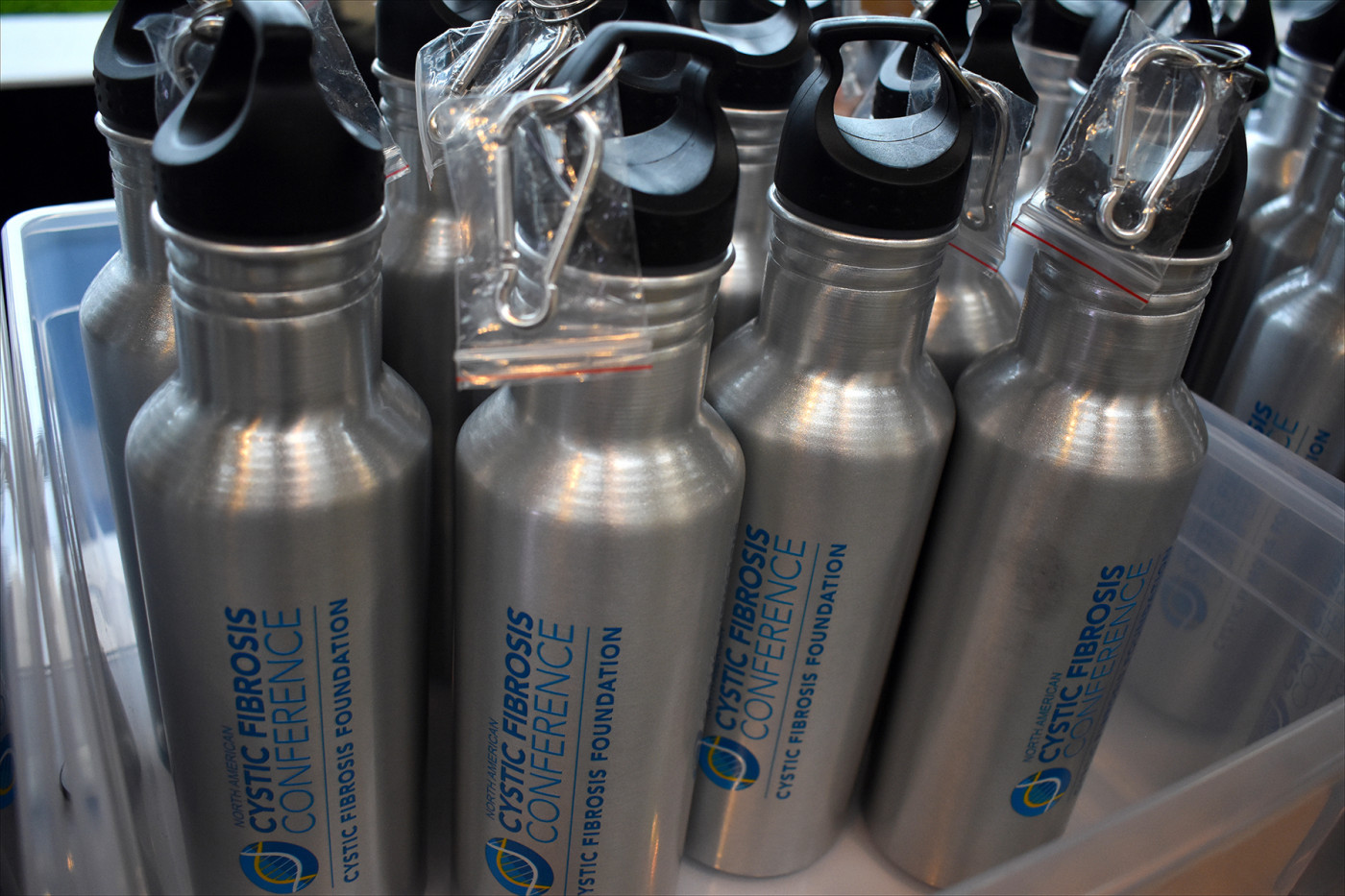Approaches Like Yoga, Along with Meds, Key to Managing CF Pain, Experts Say
Written by |

Souvenir water bottles are distributed at NACFC 2019 in Nashville. (Photo by Larry Luxner)
Tiffany Rich is something of a celebrity in the world of cystic fibrosis (CF). Diagnosed at birth, she graduated college while awaiting a double lung transplant. The co-founder of Salty Cysters, she’s been featured in Cosmopolitan magazine, and has written numerous blogs on the disease.
Recently, the 28-year-old patient advocate described how she uses physical therapy rather than medications to overcome the pain that’s frequently associated with CF.
Speaking via video from her Brentwood, California, home to delegates at the 2019 North American Cystic Fibrosis Conference (NACFC) in Nashville on Oct. 31, Rich said that her parents always encouraged her younger self to be physically active — and that participating in soccer, gymnastics, and dancing helped later on.
But lung infections started increasing in frequency in middle school, and by high school Rich was getting antibiotics once a year.
“In college, that’s when I saw my lung function slowly dropping,” she said. “At 21, I caught a really bad infection, and my lung function plummeted from 50% to 22%, and I had to be on oxygen for the first time. I lost a lot of weight and was in the hospital for a long time.”
By the age of 23, Rich’s lung function had fallen to a steady 30%. After three hospitalizations in one year, Rich was told on March 12, 2014, that she needed a double lung transplant.
Exactly 973 days later, on Nov. 30, 2016, she underwent the surgery.
“I was in pain and agony. I had coughing attacks multiple times a day, every few minutes. There was so much mucus I couldn’t get rid of it,” she said. “I had to hunch over to protect my lungs, and was in a lot of pain — in the neck, the shoulders, the upper back, the lower back. But I figured out ways to combat the pain without using medications. I take enough meds as it is.”
Rich found that massage therapy — during which time she remained on oxygen — was a big help. She also started practicing stretching and bone rolling, even in bed.
“I found that I could roll on a foam roller side to side and up and down with my back, and open those airways. It made me feel like my pain was going away,” she said. “Sitting on a yoga ball was also helpful. I would try to do all my treatments while sitting on it, because that helped my posture and prevented me from going into a hunched-over position by forcing me to sit upright.
“I’m able to live my life now, but there’s still pain. Even after a lung transplant, you’re still sick. It’s not a cure,” Rich added. “I’m doing everything I can to keep my body going … a lot more than a normal person would. All these techniques have helped me regulate my pain.”
Pain ‘a fact of life’ with CF
Melissa Richmond, a CF specialist at British Columbia Children’s Hospital in Vancouver, said pain in children with the disease is clearly associated with a poorer quality of life, pulmonary exacerbations, anxiety, joint pain, and concurrent disorders.
“We’re only on the cusp of beginning to understand pain in many chronic diseases, including CF,” said Richmond, whose institution is participating in an open-label Phase 3 study (NCT03691779) evaluating Trikafta (tezacaftor/ivacaftor/elexacaftor), the recently approved Vertex triple-combo therapy, in adolescents ages 6 to 11.
Lena Rabideau is a physical therapist with the Cystic Fibrosis Center at the Lurie Children’s Hospital of Chicago. She said people with CF are two to three times more likely to experience depression, anxiety, or both, compared to those in the general population.
“A big part in treating any type of chronic pain is to maintain a patient’s mental health,” she said, adding that even one yoga session reduces anxiety and joint pain in CF patients who try it.
In fact, pain is a fact of life for most with CF, said Sarah Allgood, an assistant professor at Baltimore’s Johns Hopkins University School of Nursing.
“I could probably spend a whole hour talking to you about what we don’t know,” said Allgood, a specialist on the subject of pain and CF. “But 77% of adults and 42% of children and adolescents with CF do experience some type of pain.”
It can be difficult to classify what is really CF-related pain, she cautioned.
“Adolescents tend to have episodic pain attributable to a specific factor, whereas in adults, it tends to be more pervasive and chronic,” Allgood said. “It’s something they live with, as opposed to something they can pinpoint. But no matter what the cause, those with pain have worse clinical outcomes.”
According to a 2016 article that Allgood co-authored, “The Association Between Pain and Clinical Outcomes in Adolescents With Cystic Fibrosis,” published in the Journal of Pain and Symptom Management, pain in adolescent CF patients is distributed in the abdomen (42%), head/sinus (32%), joints (19%), chest (10%), back (6%), and muscles (3%).
“There’s been very limited research done looking at pain as a symptom in CF, what people are doing to self-manage, and how are patients accessing healthcare,” she said.
How do patients manage pain?
Some answers can be derived from a survey Allgood helped to conduct of 377 CF patients ranging in age from 14 to 70. Of them, 76% were females, and 29.4% of them were unemployed due to health issues. In addition, 65.8% had private insurance, and 10.6% had had lung transplants.
“The most important question we asked was, ‘Do you believe the pain you’re experiencing is related to CF?’ Of the total, 50.5% said definitely yes, and 31.1% said probably yes,” she said. Typical pain locations were the abdomen (80.1%), head or sinuses (79.2%), lower back (73.2%), joints (68.9%), and chest (59.6%).
A large majority, 83.5% of respondents, had three or more pain locations, 49.6% were in pain at least four times a week, and 32.1% said pain affects their lives overall.
“One 37-year-old woman told us: ‘I don’t want to get out of bed. I don’t feel like doing treatments. I don’t want to get ready or go anywhere. I explain to people that it’s like having the flu every day, all day,” she said. “Another woman, 32, said: ‘I feel like I’m destined to a life forever in pain. It makes me feel tired, cranky and out of control.’”
CF patients responding to Allgood’s survey managed their pain in a variety of ways, led by acetaminophen (62%) and nonsteroidal anti-inflammatory drugs (60.5%). In addition, 37.2% were on medications specifically prescribed for their pain, and of those 47.1% were taking opioids.
“Those on opioids are more likely to have lower socioeconomic status and lower lung function, and tend not to be working due to their health,” Allgood said.
Other common medications for CF-related pain are selective serotonin reuptake inhibitors (35.4%), steroids (33.3%), anti-seizure drugs (25%), and marijuana (14.6%). Of those using marijuana, Allgood said, addiction was a big concern. But “a lot of them expressed frustration at the ineffectiveness of the medications they were taking.”
Interestingly, the survey also found that 27% of patients never discussed pain with their CF care team.
“Most said they were simply not asked. Other people talked about how their pain is dismissed,” Allgood said. “People don’t want to take more pills, so they figure, ‘if I can’t get help for my pain, why talk about it?’ There are always more pressing issues, like pulmonary exacerbations and lower lung function.
“But 65.9% of our respondents want pain discussed at every outpatient visit.”









